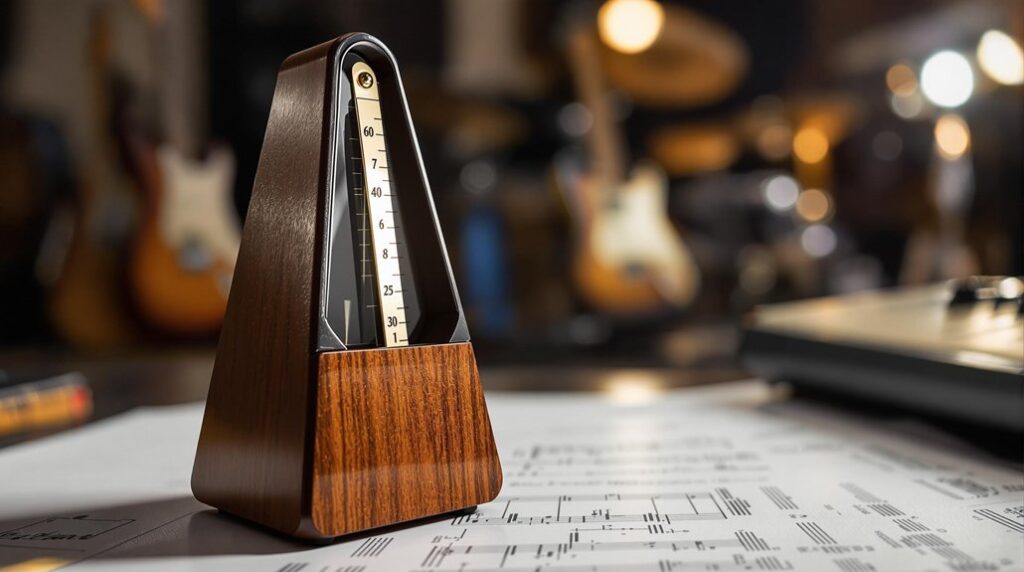To kickstart your music journey, focus on these seven essential tips. First, understand musical notes and how they relate on the staff. Next, explore scales and modes to express varied emotions. Master basic chords and progressions to create harmonic depth. Grasp rhythm and meter for a solid beat foundation. Utilize music notation for clear communication of your ideas. Recognize the importance of melody and harmony, as they shape emotional connections. Finally, apply theory practically to enhance your songwriting and musicality. These foundational concepts will greatly benefit you as you grow, and more insights await just ahead!
Key Takeaways
- Understand the basics of musical notes, including pitch, sharps, and flats, to read and write music effectively.
- Familiarize yourself with major and minor scales, as they form the foundation for melodies and harmonies.
- Learn common chord progressions like I-IV-V to create a strong structure in your compositions.
- Explore the relationship between melody and harmony to enhance emotional depth in your music.
- Practice rhythmic variations and syncopation to add excitement and interest to your musical pieces.
Understanding Musical Notes
Understanding musical notes is essential for anyone diving into music theory, as they serve as the foundation for everything you’ll learn.
Musical notes represent pitch and are named A through G, repeating in higher or lower octaves. Each note can be altered by sharps (♯) or flats (♭), raising or lowering the pitch by a half step. Whole steps consist of two half steps, forming the basis of scales.
The chromatic scale includes all twelve pitches within an octave, while major and minor scales rely on specific patterns of whole and half steps.
To read music, you’ll need to grasp musical notation, which uses a staff of five lines and four spaces to indicate the pitch of each note. Understanding EQ basics is also crucial, as it helps in shaping the tone of musical notes for better clarity and balance.
Exploring Scales and Modes
Understanding major and minor scales is essential for building your musical foundation, as they shape your melodies and harmonies.
Once you grasp these scales, exploring modes will open up new sonic possibilities, allowing you to create unique sounds by starting on different scale degrees.
Let’s uncover how these elements can enhance your improvisation and composition skills! Additionally, musical scales form the backbone of melody and harmony, influencing the emotional quality of your music.
Major and Minor Scales
When diving into music theory, grasping the differences between major and minor scales is essential for any budding musician. The major scale follows a specific pattern of whole and half steps: W-W-H-W-W-W-H, producing a bright and uplifting sound.
In contrast, the minor scale can take three forms—natural, harmonic, and melodic—each bringing unique emotional qualities to your music. Understanding the seven scale degrees of the major scale (Tonic, Supertonic, Mediant, Subdominant, Dominant, Submediant, and Leading Tone) helps you build major and minor triads effectively.
This foundational knowledge is vital as you explore modes, which derive from the major scale and offer distinct tonal qualities. Embrace this journey; it deepens your understanding of music!
Understanding Modes’ Functions
As you explore the fascinating world of modes, you’ll discover that they each bring a unique flavor to your music. Derived from the major scale, modes start on different scale degrees, creating distinct interval patterns and emotional qualities.
For instance, the Dorian mode offers a minor feel with a raised sixth, while the Mixolydian gives a major vibe with a lowered seventh. Understanding these modes enhances your ability to create diverse melodic lines and harmony.
Each mode’s unique set of notes can evoke specific feelings, making them invaluable for composition and improvisation. Practicing scales and modes in various keys will improve your fluency, allowing you to express yourself more creatively.
Immerse yourself in modes and watch your musical expression flourish!
Mastering Chords and Progressions
Chords and progressions form the backbone of most music, and mastering them is essential for any aspiring musician.
Start by understanding how to build chords—major chords consist of a root, major third, and perfect fifth, while minor chords use a root, minor third, and perfect fifth. Familiarize yourself with common chord progressions like I-IV-V and vi-IV-I-V, as they provide a solid foundation.
Experiment with chord inversions to create smoother transitions and richer sound. Adding extensions like seventh chords enhances harmony and melody, allowing for deeper emotional expression. Additionally, understanding chord progressions is crucial for guiding listeners through a sonic narrative and creating emotional impact.
Remember, grasping the relationship between chords and their function within a key is vital for effective songwriting, helping you create tension and resolution in your music.
Keep practicing!
Grasping Rhythm and Meter
Building on your understanding of chords and progressions, grasping rhythm and meter is key to creating dynamic music. Rhythm is the pattern of sounds and silences, while the beat serves as the pulse that helps maintain a steady tempo. Tempo, measured in beats per minute (BPM), sets the mood—60 BPM feels slow, whereas 180 BPM feels energetic. Meter organizes beats into measures, guided by time signatures like 4/4 and 3/4. Syncopation adds complexity by emphasizing off-beats, providing surprise and tension in your musical compositions. Understanding 3/2 time signature can enhance your ability to create majestic rhythms and emotional expression in your music.
| Concept | Definition |
|---|---|
| Rhythm | Pattern of sounds and silences |
| Meter | Organization of beats into measures |
| Syncopation | Emphasis on off-beats to create interest |
Embrace these concepts as you continue learning music theory!
Utilizing Music Notation
Understanding music notation is essential for translating your musical ideas onto the page. It uses a staff with five lines and four spaces to represent different pitches, where each line and space corresponds to specific notes played.
Clefs, like treble and bass, indicate the pitch range for these notes. Time signatures at the beginning of a piece specify the number of beats in a measure, guiding your rhythm.
Key signatures denote the sharps or flats affecting your piece, ensuring consistent pitch. Additionally, dynamics indicate how loud or soft the music should be, with terms like “piano” for soft and “forte” for loud. Mastering note values and rhythms will help you interpret musical pieces more accurately.
Familiarizing yourself with these elements will enhance your ability to compose and perform effectively.
Importance of Harmony and Melody
Harmony and melody are the backbone of any great musical piece, each serving a distinct yet interconnected purpose.
While melody drives the musical identity and often stays in your head, harmony enhances the emotional impact, adding depth and richness.
Understanding how these elements work together won’t only improve your compositions but also uplift your listening experience. Mastering chord progressions can further enhance the interplay between harmony and melody, creating more engaging musical narratives.
Harmony Enhances Emotional Impact
While you might think of melody as the primary driver of emotional expression in music, the role of harmony is equally essential. Harmony greatly enhances emotional depth through its interplay with melody. Consonant harmonies evoke feelings of happiness, while dissonant harmonies introduce tension.
| Harmony Type | Emotional Effect |
|---|---|
| Consonant Harmonies | Pleasing, stable emotions |
| Dissonant Harmonies | Tension, complexity |
| Common Progressions | Establish tonal centers |
Chord progressions, like I-IV-V, guide your emotional journey, allowing you to explore various feelings. By understanding harmonic structure and making intentional chord choices, you can craft compelling pieces that resonate deeply with listeners. Embrace the power of harmony!
Melody Drives Musical Identity
Melody serves as the heartbeat of a musical piece, defining its character and making it instantly recognizable. It’s a sequence of notes that forms memorable phrases, driving a composition’s identity.
While harmony supports the melody with simultaneous notes, it evokes emotional responses through consonant and dissonant intervals. Chords, derived from harmonies, enrich melodies; major chords bring brightness, while minor chords convey deeper feelings.
Understanding chord progressions is essential, as they shape the emotional journey of your music. Additionally, mastering melodic motion—whether through conjunct (small steps) or disjunct (large leaps)—can raise your melody, making it more compelling.
Embrace the interplay of melody and harmony to create music that resonates with listeners and leaves a lasting impression.
Practical Applications of Theory
Understanding how to apply music theory can transform your songwriting and enhance your overall musicality.
Start with chord progressions; using the common I-IV-V can provide a solid foundation for your compositions. The circle of fifths simplifies transposing songs, ensuring you maintain harmonic relationships when shifting keys.
Experiment with chord extensions like adding a 7th or 9th to basic chords—this enriches your harmonies and adds depth. Don’t forget to incorporate rhythmic variations like syncopation for added excitement in your music.
Regularly analyzing existing songs through the lens of theory will give you a deeper understanding of successful structures, ultimately fueling your creativity. Furthermore, mastering triad inversions enables smoother transitions and adds dynamic texture to your compositions.
Embrace these practical applications to uplift your music production and songwriting skills.
Frequently Asked Questions
What Is the First Thing I Should Learn in Music Theory?
You should start by learning clef symbols and note names. Then, plunge into scale degrees, intervals basics, and time signatures. Understanding these concepts will build a strong foundation for exploring chord structures and rhythmic patterns.
What Is the Rule of 5 in Music Theory?
The Rule of 5 highlights the fifth interval in chord functions, using diatonic chords within major and minor scales. Embrace circle progressions for smoother voice leading, and you’ll strengthen your understanding of harmonic relationships in music.
What Are the 12 Keys in Music Theory?
You’ll discover 12 keys, each with major and minor scales, unique key signatures, and tonic chords. Use circle progression and modulation techniques to navigate enharmonic equivalents and explore relative minors for richer musical expression.
What Is 7 in Music Theory?
In music theory, “7” refers to seventh chords, enhancing harmonic functions in major and minor scales. They play vital roles in chord progressions, voice leading, and jazz harmony, adding depth and complexity to your compositions.
Conclusion
By grasping these seven essential music theory tips, you’re setting yourself up for success on your musical journey. Understanding notes, scales, chords, rhythm, notation, harmony, and melody will not only enhance your skills but also deepen your appreciation for music. Remember, practice is key, so don’t hesitate to apply what you learn. Keep exploring and experimenting, and soon you’ll find your own unique voice in the world of music. Enjoy the process, and have fun!




